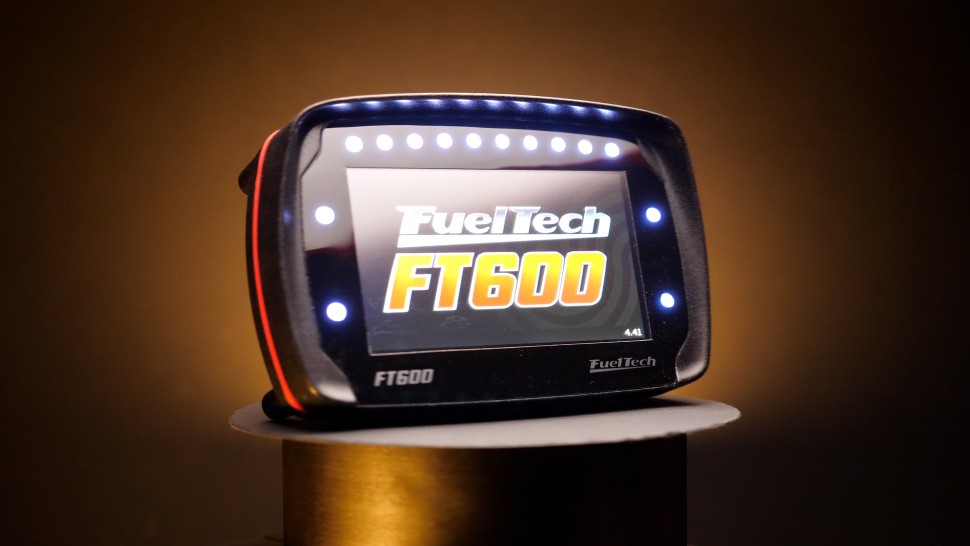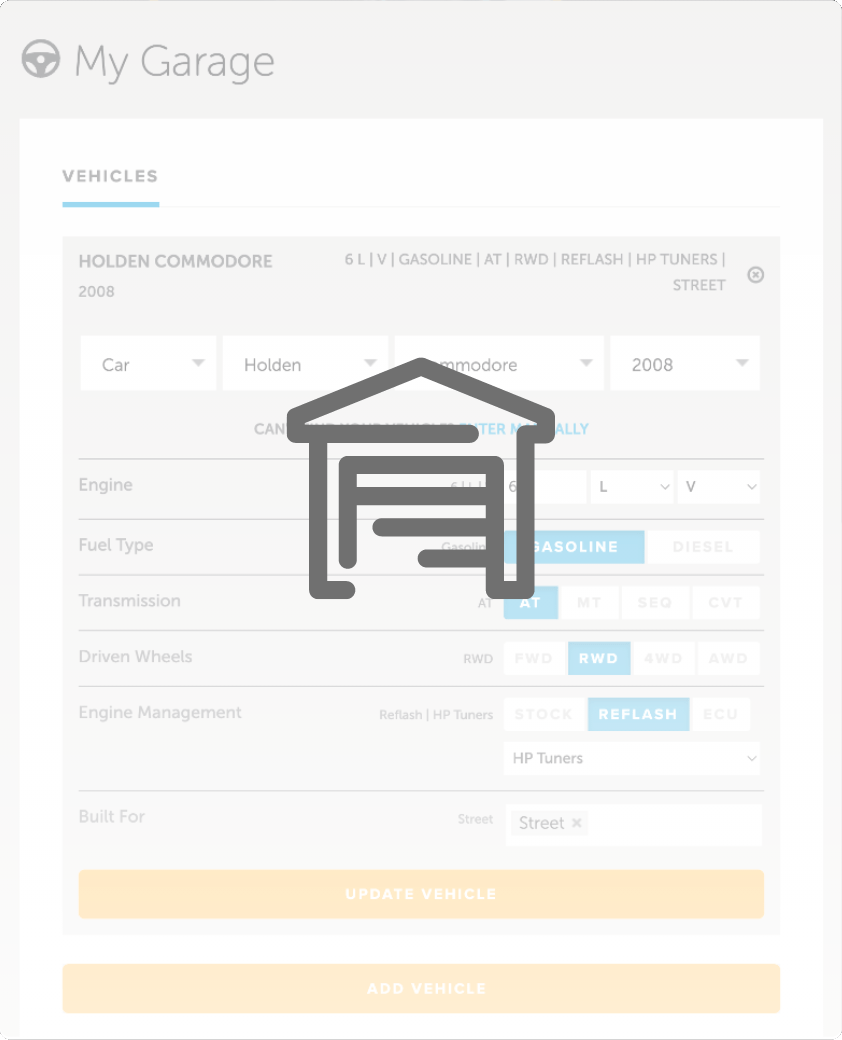| 00:00 |
The third step of our 10 step process is our table configuration, essentially getting our tables configured so that we've got suitable breakpoints to suit our engine and operating parameters and that the numbers in them are going to be sufficient to hopefully get us up and running reasonably quickly and easily.
|
| 00:16 |
As you're probably picking up at this point in this worked example, things with the Holley Sniper 2 are going to be dealt with slightly differently and that's because I'm trying to replicate the way I think most people will install and use one of these computers and in this basic situation, the ECU already builds up a base calibration using the tuning wizard which we've already gone through in the last step.
|
| 00:39 |
So, we've got a lot of the heavy lifting there done for us and we want to see how well that actually works out.
|
| 00:46 |
Let's jump into our laptop tuning software and have a look through the various tables and see what we need to know and what we need to adjust.
|
| 00:53 |
So, we're starting here on our base fuel table or VE table.
|
| 00:57 |
And if we can also view this in fuel flow, if we click on this little conversion box here, that will demonstrate our fuel flow in pounds per minute but I'm going to tune in VE numbers.
|
| 01:10 |
Interestingly we can see we've got some values here that are white, basically this means that we don't have enough fuel for that particular area but I'm not really too worried about that because you'll see that the breakpoint there for our manifold absolute pressure is 210 kPa.
|
| 01:26 |
We're not going to get anywhere near that with our naturally aspirated engine so no problem, nothing to worry about.
|
| 01:33 |
Everything's nicely colour coded to give us a bit of an idea with the heat map colouring as to what our values are and this makes it really easy to also pick up any glaring holes in our map so if for example we came to this particular site here and it had a 30 in it, we would see that straight away that sticks out so we don't need to look too hard to find a particular problem.
|
| 01:57 |
Now, one of the things I find with the Holley Sniper 2 is that the breakpoint or table resolution is just ridiculously over the top tight.
|
| 02:06 |
And we can see for example here we've got breakpoints at 1, 4, 8, 11 and 12, sorry 15 kPa.
|
| 02:15 |
Likewise, if we look at our RPM here, we've got 5, 6, 7, 8, 900, 1000, 1200 and 1400 RPM.
|
| 02:23 |
Just unnecessarily tight and all this does is needlessly makes work for the tuner.
|
| 02:30 |
We need to understand that the ECU is going to be able to interpolate between zones so we don't need to have them as tight as a lot of people think and through the body of the course, I've made recommendations on having our RPM breakpoints perhaps every 500 RPM, a little bit tighter down in the idle and just off idle regions, maybe there I might have another zone at 750 RPM, maybe another one at 1250 RPM.
|
| 02:53 |
Likewise, our breakpoints on the load axis, I'd normally have them every 20 kPa and again maybe with a little bit more resolution as and where it's necessary.
|
| 03:04 |
So, what do we do here? Well Holley don't make this particularly easy.
|
| 03:10 |
There's no sort of easy way of rescaling all of these axis values.
|
| 03:15 |
Yes we can make individual changes so if I come into this particular site here, I can change that to 1100 if I want but it's not easy to delete unnecessary breakpoints and we don't have a wizard to create the breakpoints as we want them.
|
| 03:31 |
So, what are we going to do here? Well we could definitely go through and rescale the entire axis and basically just end up with a bunch of numbers over here on the right hand side that are kind of out of our way so that we get our actual breakpoints where we want them.
|
| 03:46 |
And we could do exactly the same with the load axis, just basically have a whole lot of positive values here that we're never going to get to so that we actually have sensible breakpoints in our table area that we're running in.
|
| 03:59 |
My sense is however that 90%, maybe 95% of tuners who are using one of these units probably aren't going to do that because that in and of itself is quite a lot of work.
|
| 04:09 |
Also worth mentioning that if you do change a breakpoint, which you probably just saw me do here, let's go back to this, we'll see the values above this 1000 RPM breakpoint that I just highlighted and changed and if we change that back to let's say 1150, we will see that none of those values in that column above actually change.
|
| 04:29 |
So, it's not interpolating or changing those values to suit which most ECUs do when we make a change to the breakpoint.
|
| 04:36 |
So, very very important that we make any changes to these breakpoints now before we start tuning because if we tune this table and then we adjust the breakpoints, it's going to have a dramatic or potentially dramatic effect on our tuning.
|
| 04:48 |
So, against my better judgement we are going to leave these incredibly tight breakpoints and we're just going to deal with this as we get into our tuning and again the option is there to change them but I'm going to go through what I think is going to be the most common case study for how this ECU is going to be used.
|
| 05:07 |
So, the other thing I'll normally do with this is set all of our VE to let's say a number of around 50%, just to get ourselves up and running, should be close enough to get our engine running, it's not going to be perfect but that'll be good enough and then we can make changes from there.
|
| 05:22 |
In this case I am going to actually leave that base calibration that the wizard has created and we're going to see how good that is because we are going to be leaning heavily into this self tuning, just see how well that works out.
|
| 05:34 |
So, slight differences from how I've dealt with the other worked examples and the body of the course.
|
| 05:40 |
Now, if you want to view this graphically we can see the next tab down here is fuel graph and we see a nice 3D graph, pretty much exactly as you'd expect.
|
| 05:50 |
We've already dealt with this learn table, we've got the same really really tight breakpoints here so again nothing we're going to change there.
|
| 05:57 |
We'll come down to our next option which is our target air fuel ratio table and we've got a couple of different options with this.
|
| 06:05 |
So, first of all we've got the type.
|
| 06:07 |
So, at the moment this is set to simple and this is probably going to suit a lot of tuners who are new to tuning, want to keep their life simple and have a relatively low strain engine like our stock 350.
|
| 06:18 |
So, under these conditions we simply have three points that we need to adjust.
|
| 06:23 |
We've got our idle target air fuel ratio, then we've got our cruise air fuel ratio and then finally our wide open throttle air fuel ratio.
|
| 06:32 |
These are probably all a little bit richer than what I'd ultimately be targeting, sort of at idle, 13.5 to 14.0's probably where we're going to be.
|
| 06:43 |
With more modern engines we obviously can target stoic, 14.7 to 1, the engine's going to most likely run really happily there.
|
| 06:50 |
Generally, fine with these older engines, particularly if they do have a bit of a grumpy cam in them, sometimes we do need to target an air fuel ratio that just makes them run really nicely and that can come from experimentation but often just a little bit richer than stoic actually helps with the idle.
|
| 07:07 |
Under the cruise conditions here, unless we really had a reason to run richer than stoic, we would be targeting 14.7 and wide open throttle, while I have no objections to them starting safe, 12.5 to 1 for a naturally aspirated low strung engine like this is probably a little bit conservative, I'd probably be closer to about 13.0, maybe we could richen it up a little bit at higher RPM but of course this simple mode doesn't allow that.
|
| 07:35 |
If we come across to our type though and click on 2D table which is actually a 3D table but that's OK, we've got our axes here of manifold absolute pressure versus RPM on our horizontal axis.
|
| 07:48 |
Now, we can come in here and make some more specific changes so I'm going to do exactly that and basically set this table up a little bit more how I would like it.
|
| 07:57 |
So, we'll start with this by highlighting our idle areas here and we'll come up to about 50 kPa here and we'll set that to Then the rest of the table here, I'm going to set up to about 5000 RPM here to 14.7.
|
| 08:13 |
Actually going to leave the higher RPM vacuum area here set to 14.0.
|
| 08:19 |
It's almost irrelevant for our particular engine, this isn't a racecar, it's a cruiser.
|
| 08:24 |
I don't even think this engine's actually seen 5500 RPM before so the reason I'd go a little bit richer here on a more highly strung engine or maybe one that's going to be used in competition is at higher RPM and actually I would probably make that change down maybe around about 4500 RPM, that's probably a little bit high there at 5000 but what this means is that if you're really driving the car hard and you're at high RPM, when you're in overrun, our target's going to be a little bit richer, it's going to allow a little bit of additional fuel for cooling, just helping control that combustion temperature.
|
| 09:01 |
So, from here we need to look at what we're going to be running under wide open throttle conditions and in this case we're going to be running somewhere between this 105 kPa and our 91 kPa rows so I'm going to highlight both of those and I'm going to set those to 13.0, again if we were a little bit worried about this we could highlight maybe 5500 RPM and above, maybe we'll just pull that down to 12.8 just for a little bit of safety.
|
| 09:28 |
And then probably a little bit of in between here just to help smooth between our targets here so I might go 13.4 and then 13.5, actually maybe we'll change this one here to 14.0.
|
| 09:47 |
That's going to be close enough for the moment, these don't need to be our final values, I'm just really trying to show you how this system works, we can always come back and of course manipulate these at a later point.
|
| 09:58 |
It is important to understand though once we get into the tuning that because this is a VE based system, we need to make sure that we've set our air fuel ratio targets correctly first because that is what the closed loop and fuel learning system is going to be targeting and then we're going to be tuning to those specific targets.
|
| 10:17 |
Alright, so that's covered the basis of our fuel, there are a couple of other adjustments that we do want to have a quick look at here in our temperature enrichment so we'll just click on that.
|
| 10:26 |
So, we've got coolant temperature enrichment and all I really want to know at this stage is that at least in the areas that the engine's going to be at operating temperature, in this case 160°F and above, I want to just make sure that we don't have any odd trims in there that could affect our tuning.
|
| 10:43 |
I'd like to think that's not the case but always best to trust but verify.
|
| 10:48 |
Then we've got our air fuel ratio offset.
|
| 10:50 |
So, what this allows us to do is adjust our air fuel ratio targets during cold start, well we can adjust them when the engine is hot as well.
|
| 10:58 |
Again, I'm not really going to be too fussy about this at the moment.
|
| 11:02 |
We can set these lower temperature adjustments to suit whatever target we actually want our engine to be running but again just want to make sure that in the actual normal operating temperature regions that we don't have any weird trims going on here.
|
| 11:17 |
Interestingly what we may want to do as well is at higher temperatures, maybe 220°F and above, we could always trim a little bit of additional fuel in if required.
|
| 11:28 |
Lastly we'll just come across to our air temperature enrichment.
|
| 11:31 |
And what we want to do here is just make sure that again this makes sense.
|
| 11:35 |
Now, we know from the body of the course how the air temperature affects the air density and how we can compensate that.
|
| 11:42 |
I have worked in the course in degrees centigrade, here we are stuck with Fahrenheit but it doesn't take too much work to kind of figure out what type of adjustments we want to make.
|
| 11:52 |
For the moment I'm actually going to leave these at the base calibration values.
|
| 11:58 |
There's some intricacies here with the throttle body injection and where the air temperature sensor is fitted.
|
| 12:04 |
So, at this stage we want to just test and see how these default values from Holley actually work out.
|
| 12:09 |
So, at this point we've covered our fuel tables or anything to do with our fueling that we need to adjust.
|
| 12:14 |
We're also going to jump in and have a look at our ignition for those cases where we do have our hyperspark controlling our ignition system.
|
| 12:23 |
So, again we've got the ability to have a simple system here, a simple type.
|
| 12:28 |
So, at the moment we're on our 2D table which again of course is actually a 3D table but that's OK.
|
| 12:33 |
If we go back to simple, this gives us our three adjustments for our idle target which in this case I'll probably go down to more like about 18 or 20 degrees there, let's call it 20, split the difference, cruise, yeah 44 degrees, probably somewhere in the ballpark, maybe we could make that a little bit less, a little bit more conservative to start with and then our wide open throttle, I'm going to start a little bit more conservative than this and we'll set that to 26 degrees.
|
| 13:01 |
So, that's going to, as you've seen there, make or adjust the map as we're going.
|
| 13:06 |
And if we go back to our 2D table, again 3D table, we can see what it's done there, it's basically made up a map based on those values.
|
| 13:15 |
Quite handy though if you want to make some adjustments to this table and you don't want to be sort of hand smoothing everything, you can switch it back to simple, make those adjustments like I just did, then switch back to 2D table and we've got a full table.
|
| 13:30 |
Of course, this is exactly what the ECU is doing in terms of interpolating between those three points that we gave if we do stay in that simple mode anyway.
|
| 13:39 |
So, again same breakpoints, same very tight breakpoints for our table resolution as we already saw in our fuelling and again as discussed, I'm going to leave that exactly how it is.
|
| 13:52 |
We also have the ability to show this graphically so no big surprises there, just a three dimensional graphical representation just like we saw with our fuelling.
|
| 14:02 |
Moving down we've got our cranking parameters and basically just what our cranking ignition time is going to be.
|
| 14:09 |
Normally somewhere in the region of about 10 to 15 degrees is probably there or thereabout.
|
| 14:14 |
What we can find is with higher compression engines, ones with aggressive cams, we can get better starting if we have a more conservative or more retarded cranking timing but 15 degrees in our case should have us in pretty good shape and there's a transition here between cranking and running RPM.
|
| 14:33 |
All we want to do is make sure that we don't end up exceeding this while we're cranking.
|
| 14:37 |
We already saw briefly that our cranking speed was somewhere around about 200 RPM so this should be pretty much on the money there with a cranking to run RPM transition at 400 RPM.
|
| 14:49 |
Moving down, we also want to make sure we have a rev limiter set up and in this case I'm glad that we did check because you can see that our high RPM limit here, possibly a little bit optimistic, I don't think our little 350 Chev is ever going to make it to 20,000 RPM and probably valve balance or valve float would have been the winner on the day but seeing as we're here, let's set this a little bit more conservative and I doubt we're going to probably want to run this much past about 5500 RPM so we'll start with 6000 RPM.
|
| 15:23 |
You could also be much more conservative and actually start by setting this down at maybe 3500 or 4000 RPM just while you're getting the initial setup done, just to make sure that we don't end up with a problem with maybe the throttle jammed open, resulting in more RPM on the engine than we actually intended for.
|
| 15:41 |
We can also set up a secondary rev limiter but in this case we're keeping our installation really nice and simple so we're not going to deal with that.
|
| 15:51 |
Likewise, we will not cover here launch retard, that's a little bit beyond the scope of this worked example but we do have timing versus coolant temp.
|
| 16:00 |
Sometimes we can get benefits from using slightly more advanced timing when the engine is cold, maybe for safety when the engine is operating well past its normal operating point, we might want to pull some timing out of it but at the same time we also want to just make sure that there aren't any weird numbers in here.
|
| 16:18 |
As we can see, no trims there, we've just got zero degrees across the board and we'll also click on our timing versus air temperature and exactly the same here.
|
| 16:27 |
This isn't something really we can guess on either, this actually does really require some testing to actually find out what trims, if any, our particular engine needs.
|
| 16:38 |
So, for the moment we haven't done any testing, we're going to leave that where it is.
|
| 16:41 |
So, at this point we've completed our base table configuration using our laptop software and we're ready for the next step of our process.
|
| 16:48 |
But we will also cover this using the hand controller as well.
|





